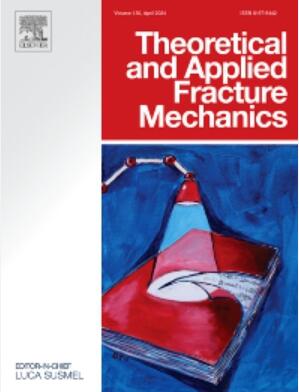Crack coalescence and failure behaviors in slate specimens containing a circular cavity and a pre-existing flaw pair under uniaxial compression
IF 5
2区 工程技术
Q1 ENGINEERING, MECHANICAL
引用次数: 0
Abstract
The flaws (fractures) widely existing in rock mass pose a threat on the stability of many underground cavities. This study aims at investigating the failure process of a cavity affected by adjacent flaws. A number of slate specimens containing a circular cavity and a pre-existing flaw pair were tested under uniaxial compression. Varied flaw configurations were obtained by changing the flaw inclination angle with respect to horizontal and the spacing between flaw pair and cavity. Three main types of cracks emanated from the pre-existing flaw tips, and played a dominant role in the failure process of cavity, comprising primary wing cracks (tensile cracks) and two types of secondary cracks (quasi-coplanar shear cracks and oblique shear cracks). The initiation and propagation of these cracks were highly dependent on the flaw pair configurations. When the pre-existing flaw pairs were non-parallel to the loading direction, (1) mostly, coalescence occurred both in the tensile and compressive stress concentration regions around cavity; (2) in most cases, the quasi-coplanar and oblique shear cracks were the predominant cracks leading to the coalescence between the compressive stress concentration regions of cavity and the pre-existing flaw pair tips. When the pre-existing flaws were parallel to the loading direction, the combination of inclined shear cracks and tensile cracks or inclined shear cracks only dominated the failure of cavity. The initiation angles of wing cracks, quasi-coplanar shear cracks and oblique shear cracks agreed well with the theoretical predictions by the maximum tangential strain criterion (MTSN), Mohr-Coulomb criterion (M−C) and maximum shear stress criterion (MSS), respectively.
在单轴压缩条件下,含有圆形空腔和预存缺陷对的板材试样中的裂纹凝聚和破坏行为
岩体中广泛存在的缺陷(裂缝)对许多地下空洞的稳定性构成威胁。本研究旨在研究受相邻缺陷影响的空洞的破坏过程。研究人员在单轴压缩条件下测试了一些含有圆形空腔和一对预先存在的缺陷的石板试样。通过改变缺陷相对于水平面的倾斜角度以及缺陷对和空腔之间的间距,获得了不同的缺陷配置。从预先存在的缺陷尖端产生的三种主要裂纹在空腔破坏过程中起主导作用,包括主要翼裂纹(拉伸裂纹)和两种次生裂纹(准共面剪切裂纹和斜剪切裂纹)。这些裂纹的产生和扩展在很大程度上取决于缺陷对的配置。当预先存在的缺陷对与加载方向不平行时,(1) 多数情况下,凝聚发生在型腔周围的拉应力集中区和压应力集中区;(2) 多数情况下,准共面剪切裂纹和斜剪切裂纹是导致型腔压应力集中区与预先存在的缺陷对尖端之间凝聚的主要裂纹。当预先存在的缺陷平行于加载方向时,倾斜剪切裂纹和拉伸裂纹的组合或倾斜剪切裂纹仅主导型腔的破坏。翼裂纹、准共面剪切裂纹和斜剪切裂纹的起始角分别与最大切向应变准则(MTSN)、莫尔-库仑准则(M-C)和最大剪应力准则(MSS)的理论预测结果吻合。
本文章由计算机程序翻译,如有差异,请以英文原文为准。
求助全文
约1分钟内获得全文
求助全文
来源期刊

Theoretical and Applied Fracture Mechanics
工程技术-工程:机械
CiteScore
8.40
自引率
18.90%
发文量
435
审稿时长
37 days
期刊介绍:
Theoretical and Applied Fracture Mechanics'' aims & scopes have been re-designed to cover both the theoretical, applied, and numerical aspects associated with those cracking related phenomena taking place, at a micro-, meso-, and macroscopic level, in materials/components/structures of any kind.
The journal aims to cover the cracking/mechanical behaviour of materials/components/structures in those situations involving both time-independent and time-dependent system of external forces/moments (such as, for instance, quasi-static, impulsive, impact, blasting, creep, contact, and fatigue loading). Since, under the above circumstances, the mechanical behaviour of cracked materials/components/structures is also affected by the environmental conditions, the journal would consider also those theoretical/experimental research works investigating the effect of external variables such as, for instance, the effect of corrosive environments as well as of high/low-temperature.
 求助内容:
求助内容: 应助结果提醒方式:
应助结果提醒方式:


